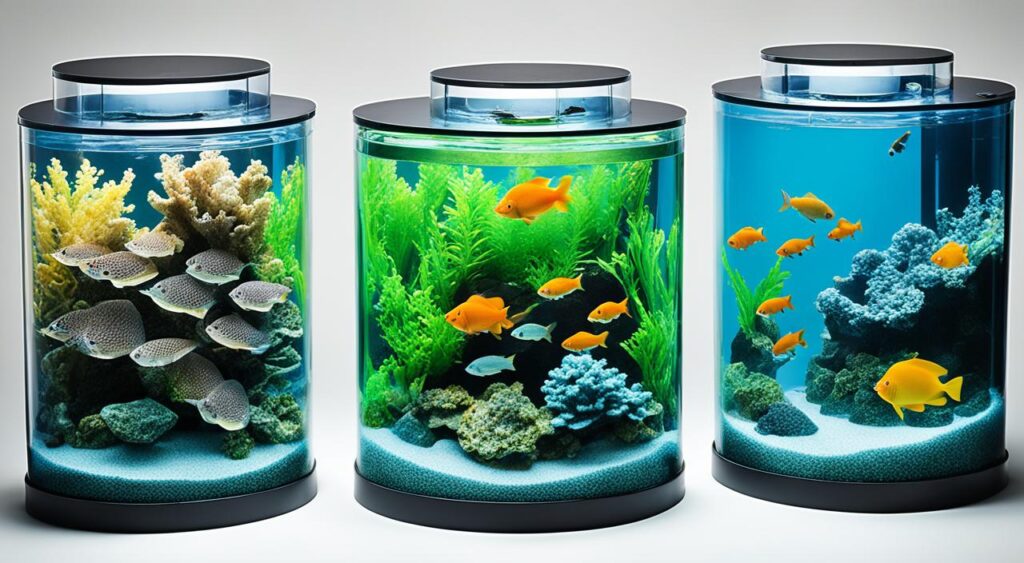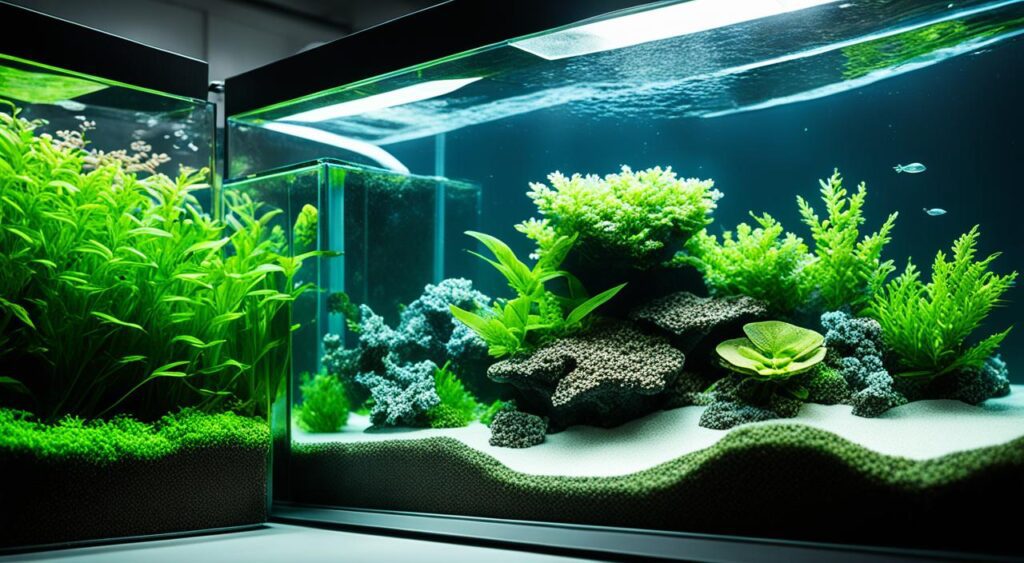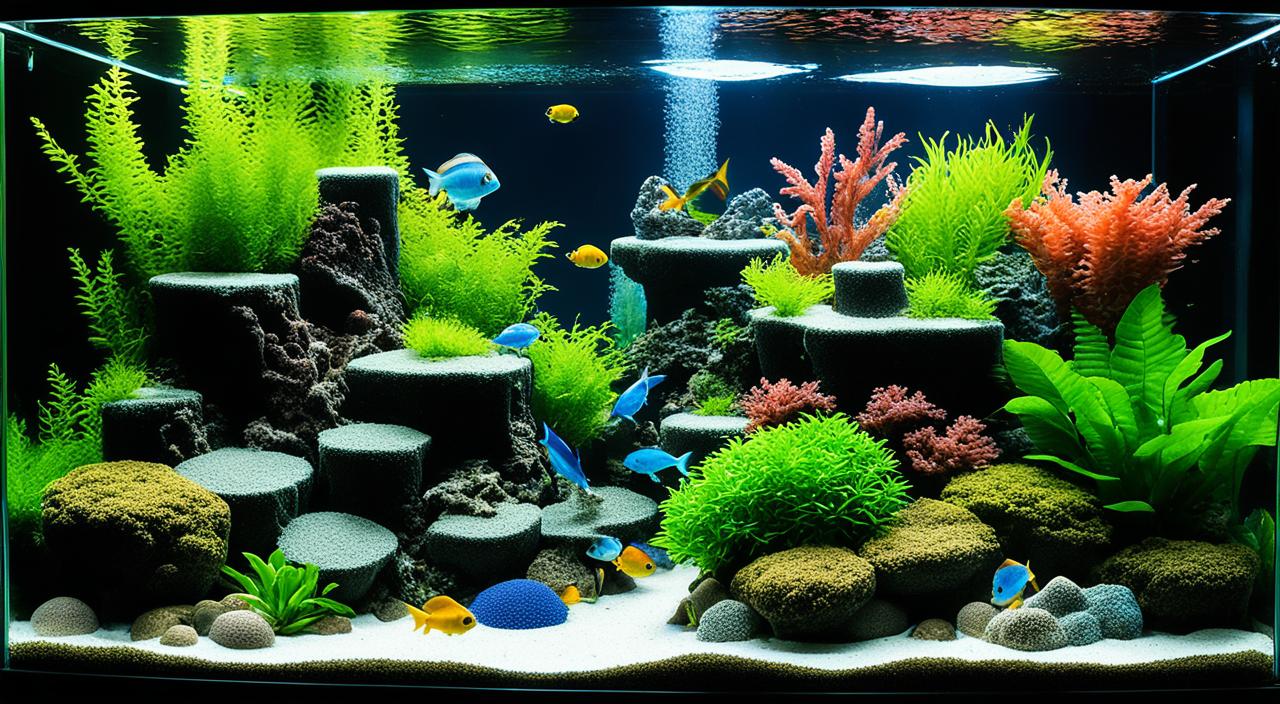Aquarium filtration media is essential for maintaining a healthy and clean environment in your aquarium. Understanding the various types of filtration media and their functions is vital to ensuring optimal tank health. This comprehensive guide will provide all the information you need about aquarium filtration media from the available media types to select the best ones for your aquarium type. Let’s dive in and explore the world of aquarium filtration!
Key Takeaways:
- Aquarium filtration media is crucial for maintaining a healthy and clean environment in your aquarium.
- Understanding the different types of filtration media is critical to selecting the best media for your aquarium type.
- Filtration media includes biological, chemical, and mechanical press, each with specific functions.
- Proper media selection and maintenance are essential for optimizing filtration efficiency and promoting tank health.
- Stay tuned for the next section, where we explore the fundamentals of aquarium filtration.
Fundamentals of Aquarium Filtration
Proper aquarium filtration is essential for maintaining a healthy environment for your fish and other aquatic life. Filtration systems play a crucial role in removing waste, maintaining water quality, and creating a chemical balance that supports the overall well-being of your tank inhabitants.
Understanding the fundamentals of aquarium filtration is crucial for ensuring optimal conditions for your aquarium. A well-designed filtration system helps in:
- Water Quality: Filtration removes impurities and toxins, ensuring clean and clear water for your fish.
- Fish Health: Filtration helps remove waste, prevent the buildup of harmful substances, and create a healthy environment for fish to thrive.
- Chemical Balance: Filtration systems assist in maintaining the appropriate chemical balance in the aquarium, creating a stable and conducive environment for the aquatic life.
Proper aquarium filtration is the foundation of a successful aquatic ecosystem, providing the necessary conditions for fish health, waste removal, and maintaining water quality.
There are three main types of aquarium filtration, each playing a vital role in the overall filtration process:
- Mechanical Filtration: This stage involves physically removing debris, particles, and uneaten food from the water. Mechanical filtration typically utilizes filter media such as sponges, foams, and pads to trap and remove solid waste.
- Chemical Filtration: Chemical filtration targets specific contaminants and toxins in the water using filter media like activated carbon and specialized resins. These media adsorb and remove impurities, resulting in cleaner water.
- Biological Filtration: Biological filtration is the heart of the nitrogen cycle and involves the growth of beneficial bacteria that convert harmful ammonia into less toxic substances. Biological filtration media, such as bio-rings, sintered glass, and bio-balls, provide a surface area for bacterial colonization.
By incorporating all three types of filtration in your aquarium, you can maintain optimal water quality, promote fish health, and ensure a thriving aquatic ecosystem. Understanding the fundamentals of aquarium filtration and the importance of mechanical, biological, and chemical filtration can help you create and maintain a balanced and healthy aquarium environment.
| Filtration Type | Function |
|---|---|
| Mechanical Filtration | Removes debris, particles, and uneaten food from the water |
| Chemical Filtration | Targets specific contaminants and toxins in the water |
| Biological Filtration | Supports the nitrogen cycle and promotes the growth of beneficial bacteria |
The Path of Water Through Aquarium Media Filtration
Understanding the water path through aquarium media filtration is essential for maintaining clean and healthy water in your tank. This process involves a sequence of filtration that ensures the efficient removal of particles and contaminants and the promotion of bacterial growth for the nitrogen cycle.
Sequence of Filtration: Understanding the Correct Order
The aquarium filtration sequence follows a specific order to optimize water flow and filtration efficiency. It begins with mechanical media, which acts as the first line of defense, followed by chemical media for targeted contaminant removal, and ending with biological media, which supports the essential nitrogen cycle and promotes beneficial bacterial growth.
Mechanical Media: The First Line of Defense
Mechanical media, which consists of sponges, filter pads, and filter floss, plays a crucial role in particle removal from the water. As water passes through the mechanical media, larger debris, uneaten food, and other physical particles are trapped and prevented from circulating in the aquarium. This step removes visible impurities, resulting in cleaner water.
Chemical Media Filtration: Targeting Specific Contaminants
Chemical media is designed to target and remove specific contaminants from the water. Activated carbon and specialized resins are commonly used chemical media. Activated carbon adsorbs dissolved organic compounds, odours, and toxins, while specialized resins target specific pollutants such as ammonia or heavy metals. This step ensures the removal of harmful substances that can negatively impact the health of your aquarium inhabitants.
Biological Media: The Heart of Nitrogen Cycle
Biological media is essential for establishing and maintaining the nitrogen cycle in your aquarium. It provides a surface area for beneficial bacteria to colonize and grow. These bacteria break down toxic ammonia produced by fish waste into nitrite and further convert nitrite into the less harmful nitrate. The presence of biological media ensures the continual removal of poisonous substances, promoting a healthy and balanced aquarium ecosystem.
To better understand the path of water through aquarium media filtration, refer to the diagram below:
| Filtration Step | Media Type | Key Role |
|---|---|---|
| 1 | Mechanical media | Physical particle removal |
| 2 | Chemical media | Targeted contaminant removal |
| 3 | Biological media | Promotes nitrogen cycle and bacterial growth |
Different Types of Media Filtration and Their Roles
Different types of media are used in aquarium filtration, each with its specific role in maintaining water quality. Mechanical media, such as sponges, foams, and pads, physically trap particles and debris, preventing them from circulating in the aquarium. Chemical media, such as activated carbon and specialised resins, adsorb and remove specific contaminants from the water. Biological media, such as bio-rings, sintered glass, and bio-balls, provide a surface area for beneficial bacteria to colonize and promote the nitrogen cycle.
Mechanical Media: Sponges, Foams, and Pads
Mechanical media acts as the first line of defence in aquarium filtration systems. Sponges, foams, and pads have porous structures that trap large particles, debris, and uneaten food from the water. As the water passes through these mechanical media, the physical barriers prevent these contaminants from re-circulating in the aquarium, helping to maintain water clarity and to avoid clogging in subsequent filtration stages.
Chemical Media: Activated Carbon and Specialised Resins
Chemical media is crucial in removing specific contaminants and maintaining water quality. Activated carbon is a commonly used chemical media that adsorbs dissolved organic compounds, odours, and discolourations from the water. Specialized resins, such as ion exchange resins, target and remove specific impurities like ammonia, nitrate, and heavy metals. These chemical media effectively remove harmful substances, improving water clarity and creating a healthier environment for aquatic life.
Biological Media: Bio-Rings, Sintered Glass, and Bio-Balls
Biological media promotes the growth of beneficial bacteria essential for the nitrogen cycle, which converts toxic ammonia to less harmful substances. Bio-rings, sintered glass, and bio-balls provide a large surface area for colonising these bacteria. The porous structures of these media allow for the attachment and growth of nitrifying bacteria, creating a robust biological filtration system. This process helps to maintain water quality and promote a healthy and balanced aquatic environment.

Aquarium Filtration Media – A Dive into Chemical, Biological, & Mechanical Media
In this section, we will explore the three main categories of aquarium filtration media: chemical, biological, and mechanical. We will investigate the various media types within each category, their specific functions, and how they contribute to maintaining water clarity, removing contaminants, and managing waste in your aquarium. This comprehensive overview of aquarium filtration media will aid you in selecting the right combination of media for your filtration system and achieving optimal biological balance in your tank.
When it comes to aquarium filtration, selecting the appropriate media types is essential for ensuring the health and clarity of your tank water. Let’s explore each category of filtration media and understand their roles:
Chemical Filtration Media
Chemical filtration media targets and removes specific contaminants from the water. Common types of chemical media include activated carbon, specialized resins, and zeolite. Activated carbon, for example, works by adsorbing impurities, odours, and discolouration, resulting in clear and odour-free water. Specialized resins can effectively remove ammonia and phosphate, helping to maintain optimal water quality. Zeolite is known for its ability to remove ammonia and heavy metals, promoting a healthy aquatic environment.
Biological Filtration Media
Biological filtration media provides a surface area for beneficial bacteria to grow and thrive. These bacteria convert harmful ammonia and nitrites into less toxic nitrates through the nitrogen cycle. Popular types of biological media include bio-rings, sintered glass, and bio-balls. Bio-rings offer a large surface area for bacterial colonization and are highly effective in promoting biological balance. Sintered glass and bio-balls also provide ample space for bacterial growth while ensuring optimal water flow.
Mechanical Filtration Media
Mechanical filtration media acts as a physical barrier, trapping debris, uneaten food, and other visible particles suspended in the water. Common types of mechanical media include sponges, foams, and filter pads. These media effectively remove larger particles and contribute to water clarity by preventing them from circulating in the aquarium. Regular cleaning and maintenance of mechanical media are essential to avoid clogging and ensure optimal filtration efficiency.
Choosing the right combination of media for your aquarium filtration system is crucial for achieving optimal water clarity, contaminant removal, waste management, and maintaining a biological balance. When selecting media, consider the specific needs of your aquarium, its inhabitants, and the desired water parameters. For a successful media selection process, it is recommended that you consult with an experienced aquarist or seek guidance from reputable brands and professionals in the industry.
Refer to the table below for a comparison of the main characteristics and benefits of different aquarium filtration media types:

“The right combination of chemical, biological, and mechanical filtration media is key to maintaining a healthy and vibrant aquarium ecosystem.”
Media Filtration, Aquarium Filtration Media
Selecting the ideal media for your aquarium type is crucial for maintaining water quality and the health of your tank inhabitants. When choosing aquarium media filtration, several factors to consider include media compatibility, lifespan, and efficiency. This section will guide you through selecting the ideal media for your aquarium, ensuring optimal filtration and a thriving aquatic environment.
Selecting the Ideal Media for Your Aquarium Type
When selecting media for your aquarium, it is essential to consider the specific needs of your tank inhabitants. Different types of fish and aquatic life require different filtration requirements. Some species may need more robust mechanical filtration to remove waste and debris, while others may benefit from a heavier emphasis on biological filtration to support the nitrogen cycle. Understanding the biology and requirements of your aquarium inhabitants will help you choose the appropriate media for your filtration system.
Before selecting media, evaluate your filtration system’s compatibility with different media types, ensuring they fit seamlessly into your setup. Some filtration systems are designed to work with specific media types, so choosing media compatible with your system for optimal performance is essential.
Additionally, the lifespan and efficiency of different media types should be considered. Some media may need to be replaced more frequently due to clogging or reduced effectiveness. Understand the lifespan of your chosen media and plan for regular replacement to maintain effective filtration.
Chemical Media Brands: Seachem vs. Acurel Efficiency
Two popular brands of chemical media are Seachem and Acurel. These brands offer a range of products designed to target specific contaminants in aquariums.
Seachem is known for its high-quality products that effectively remove toxins and impurities from aquarium water. Their line of chemical media, including activated carbon and specialized resins, provides efficient and reliable filtration results. Seachem’s media products are formulated to achieve optimal water clarity and promote a healthy aquatic environment.
Acurel is another trusted brand in aquarium filtration. Their chemical media solutions, such as activated carbon and specialty resins, are designed to remove impurities and maintain water quality effectively. Acurel’s media products are known for their efficiency and ability to absorb contaminants, ensuring a clean and healthy aquarium environment.
When comparing Seachem and Acurel, it is crucial to consider your aquarium’s specific filtration needs and the contaminants you are targeting. Both brands offer high-quality products, but their effectiveness may vary depending on the application and water conditions. Research and customer reviews can help you decide based on your aquarium’s unique requirements.
Balancing Mechanical and Biological Media in Established Tanks
Finding the right balance between mechanical and biological media is essential for optimal filtration in an established aquarium. Mechanical media, such as sponges and pads, physically trap debris and particles, preventing them from circulating in the water column. On the other hand, biological media provide a surface area for beneficial bacteria to colonize, promoting the nitrogen cycle and ensuring efficient waste breakdown.
When balancing mechanical and biological media, it is essential to consider the needs of your aquarium inhabitants and the specific waste production of your tank. Some fish produce more waste than others and may require more robust mechanical filtration to remove excess debris. Assess the waste load and adjust the mechanical-to-biological media ratio accordingly.
Monitoring water parameters, such as ammonia and nitrite levels, is crucial when balancing mechanical and biological media. Adequate biological filtration is essential for converting toxic ammonia and nitrite into less harmful substances. If ammonia or nitrite levels are consistently high, consider increasing the amount of biological media or adding more efficient strains of beneficial bacteria.
Proper media selection and balancing allow you to achieve optimal filtration in your established tank, ensuring a healthy and thriving aquatic ecosystem.
Conclusion
In conclusion, optimizing your aquarium’s filtration system through streamlined media selection is key to achieving optimal filtration efficiency. By understanding the roles of different filtration media, you can create a clean and healthy environment for your aquatic life.
Streamlining Media for Optimal Filtration Efficiency
To ensure optimal filtration efficiency, choosing the right combination of mechanical, chemical, and biological media for your aquarium is essential. Mechanical media, such as sponges, foams, and pads, effectively remove physical particles and debris from the water. Chemical media, such as activated carbon and specialized resins, target specific contaminants, ensuring clean and chemical-free water. Biological media, such as bio-rings, sintered glass, and bio-balls, provide a surface area for beneficial bacteria to thrive, supporting the vital nitrogen cycle.
Maintenance Practices to Maximize Filter Media Longevity
Maintaining the longevity of your filter media is essential for sustained filtration effectiveness. Regular cleaning and maintenance, such as rinsing mechanical media to remove trapped debris and replacing chemical media as needed, will help ensure optimal performance. Monitoring flow rates and checking for clogs or blockages in your filtration system is also crucial. Regularly testing water parameters, such as ammonia and nitrite levels, will help you identify any issues and take corrective measures promptly.
By following these maintenance practices and keeping your filter media in good condition, you can maximize its lifespan and enjoy clean water solutions for your aquarium. Remember to refer to the manufacturer’s guidelines for specific maintenance instructions and recommendations.
Ultimately, understanding the functions of different filtration media and implementing proper maintenance practices will lead to clear, healthy water and a thriving aquatic environment. Invest time and effort into selecting the ideal media and maintaining your filter system. You’ll be rewarded with an aquarium that provides a natural habitat for your beloved fish and aquatic life.

